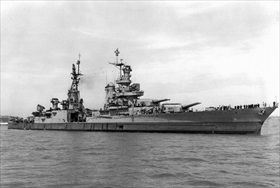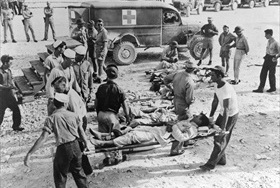USS INDIANAPOLIS LEAVES ON SECRET MISSION
San Francisco, California • July 15, 1945
On this date in 1945 the USS Indianapolis, a fast Portland-class cruiser in California for repairs, received orders to pick up some special cargo at Hunters Point (predecessor name for the now-closed San Francisco Naval Yard). Eleven days later, on July 26, Indianapolis unloaded her mysterious cargo—a large crate that had been secured to its deck and a 2‑ft/61‑cm-long metal cylinder placed in the flag lieutenant’s cabin—all delivered under tight security to the B‑29 Superfortress heavy bomber base on the Central Pacific island of Tinian in the Marianas.
Four days later, just after midnight on July 30, six Type 95 wakeless torpedoes, the fastest and most deadly in use by any underwater navy in World War II, were launched, 3 seconds apart, by Japanese submarine I‑58. Two 1,200-pound warheads struck the Indianapolis 50 seconds later, one in the bow and one amidships, as the heavy cruiser was en route to Leyte Gulf in the Philippines for gunnery drills in anticipation of the Allied invasion of Japan. In so doing I‑58 inflicted the greatest loss of life in U.S. naval history: 300 officers, sailors, and Marines were killed in the 27‑minute attack, and the remaining 800 of the ship’s complement bobbed in the unforgiving sun and shark-infested waters of the South Pacific for four days and nights without the U.S. Navy being aware they were missing. When at last they were accidentally spotted by a Navy patrol bomber on a routine mission and rescued the next day, August 3, just 316 out of the original 1,196 sailors and Marines had survived the sinking, exposure to oil, sun, and sea, dehydration, saltwater poisoning, and prowling sharks—reputedly the most shark attacks on humans in history. News of the tragedy was withheld from the American public for 16 days and went largely unnoticed owing to the momentous events of August 6 and 9 on the Japanese homeland.
(A scapegoat Naval court-martial convened in late 1945 would declare Indianapolis’ skipper, 46-year-old Captain Charles B. McVay III, culpable for the loss of his ship, although Indianapolis, which had a top speed of 32.5 knots, had neither escort vessel [requested but rejected as unnecessary] nor underwater detection equipment, which conceivably could have altered events. The ill-fated cruiser was on her own in presumably safe waters. Fleet Admiral Chester Nimitz remitted McVay’s sentence, although his conviction still stands in Navy records. McVay committed suicide in 1968, 32 years before he was exonerated by an act of the U.S. Congress in 2000.)
Of course the key item on Indianapolis’ top-secret cargo manifest was none other than the precious fissile components for “Little Boy,” the codename for the atomic bomb dropped on Hiroshima on August 6, 1945. Developed by the Manhattan Project headed by J. Robert Oppenheimer at a cost of nearly $2 billion at the time (close to $35 billion in 2024 dollars), “Little Boy” derived its explosive power (equivalent to 15,000 tons of TNT) from the nuclear fission of less than 35 ounces/0.99 kg of uranium‑235. The Hiroshima bombing was the second nuclear explosion in history, after the Trinity test near Alamagordo, New Mexico, and the first uranium-based detonation. (The Trinity test occurred one day after Indianapolis left port for Tinian.) “Little Boy” killed perhaps 70,000 people outright. With the detonation of the more powerful plutonium‑239-based “Fat Man” over Nagasaki 3 days later, which added 40,000 more deaths to the tally of the dead (to say nothing of the forever-maimed, the chronically ill, and the recovered wounded), nuclear weapons and their peaceful offspring have exerted a profound impact on the rest of the twentieth century and into the present.
USS Indianapolis, July 1945
 |  |
Left: USS Indianapolis off California’s Mare Island, July 10, 1945, days after the heavy cruiser’s final overhaul and repair of combat damage (incurred on March 31, 1945) and five days before setting off for the Central Pacific island of Tinian to deliver critical elements of the atomic bomb that was dropped on Hiroshima, Japan. The 9,800‑ton/610‑ft-long heavy cruiser served in numerous headline-grabbing naval engagements, among them the Battle of the Coral Sea, the Battle of Midway, the Guadalcanal Campaign, the Battle of Leyte Gulf, the Battle of Okinawa, the Battle of the Philippine Sea, and the Battle of Iwo Jima. Indianapolis served as a fleet flagship for Vice Admiral Raymond Spruance when he commanded the U.S. Fifth Fleet in its battles across the Central Pacific. Sunk a half month before Japan’s unconditional surrender, Indianapolis was the last victim of the Japanese Navy.
![]()
Right: USS Indianapolis’ survivors on Guam, probably August 8, 1945. Torpedoed by Japanese submarine I‑58 on July 30, 1945, the Indianapolis rolled completely over and sank, bow first, within 12 minutes of being hit. About 800 of the 1,196 crewmen aboard initially survived the fiery sinking, although the ship’s life rafts—there were no lifeboats—could accommodate few of them. Many of the men treaded water without life vests. The wounded or badly burned simply drowned. By the time the emaciated survivors were rescued four days and five nights after their cruiser went down, only 321 remained; 4 soon died. Most of the deaths on Indianapolis were due to exposure, thirst (the fresh water aboard the life rafts was undrinkable), and saltwater poisoning, with the dead and injured and those in shock being dragged off by sharks.
A&E USS Indianapolis Documentary. Skip First 3 Minutes
![]()

 History buffs, there is good news! The Daily Chronicles of World War II is now available as an ebook for $4.99 on Amazon.com. Containing a year’s worth of dated entries from this website, the ebook brings the story of this tumultuous era to life in a compelling, authoritative, and succinct manner. Featuring inventive navigation aids, the ebook enables readers to instantly move forward or backward by month and date to different dated entries. Simple and elegant! Click
History buffs, there is good news! The Daily Chronicles of World War II is now available as an ebook for $4.99 on Amazon.com. Containing a year’s worth of dated entries from this website, the ebook brings the story of this tumultuous era to life in a compelling, authoritative, and succinct manner. Featuring inventive navigation aids, the ebook enables readers to instantly move forward or backward by month and date to different dated entries. Simple and elegant! Click 











